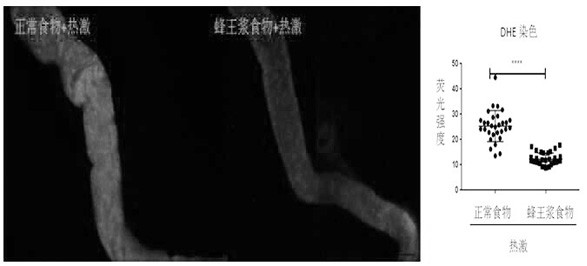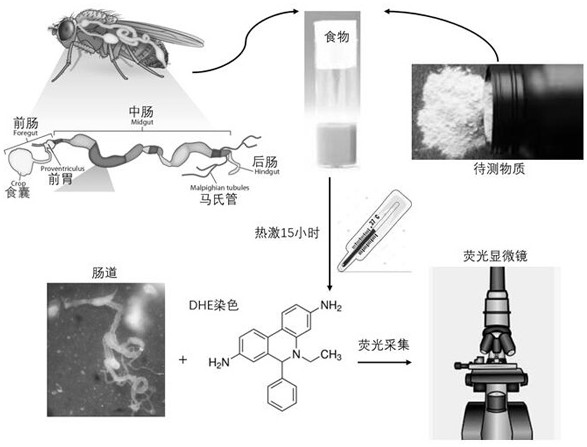Method for in-vivo detection of antioxidant capacity of functional food or medicine and application
A technology of anti-oxidation ability and functional food, which is applied in the biological field, can solve the problems of oxidative stress and harmfulness to human body, and achieve the effect of rapid screening, fast screening work, and simple feeding method
- Summary
- Abstract
- Description
- Claims
- Application Information
AI Technical Summary
Problems solved by technology
Method used
Image
Examples
Embodiment 1
[0018] A Drosophila model in which temperature stress produces an increase in ROS
[0019] Create a Drosophila intestinal reactive oxygen species increase model through temperature stress stress: collect 30 wild-type Drosophila (Canton-S) males 2-5 days after eclosion, put them in normal food, and then culture them at 37°C Take it out after 15 hours in the box (too long time may cause the death of fruit flies).
[0020] Normal food contains 0.75% soybean flour (g / ml), 4.5% corn flour (g / ml), 1.5% yeast (g / ml), 0.5% propionic acid (v / v), 0.1% methylparaben (g / ml), 0.02% corn syrup (v / v), 1.25% sucrose (g / ml), 1.25% glucose (g / ml), 0.5% agar (g / ml).
[0021] Intestinal ROS level detection:
[0022] Dissolve 1 mg DHE (Sigma, product number 37291) in 1 mL of DMSO to prepare a 3 mmol / L stock solution, take 20 µL and dissolve it in 1 mL of PBS to obtain a DHE staining solution with a concentration of 60 µmol / L, which is now prepared use, keep away from light;
[0023] Dissolve 8...
Embodiment 2
[0028] Antioxidant effect of royal jelly
[0029] The antioxidant effect of royal jelly was analyzed. Specific plan: First, prepare food containing royal jelly, fresh royal jelly is mixed with 0.75% soybean flour (g / ml), 4.5% corn flour (g / ml), 1.5% yeast (g / ml) with a final mass fraction of 20%. ml), 0.5% propionic acid (v / v), 0.1% methylparaben (g / ml), 0.02% corn syrup (v / v), 1.25% sucrose (g / ml), 1.25% glucose (g / ml), 0.5% agar (g / ml) food. The control was normal food (that is, food without adding fresh royal jelly).
[0030] Collect 60 wild-type Drosophila (Canton-S) males 2-5 days after eclosion and divide them into two groups. After heat shock treatment in the incubator for 15 hours, take it out. Then DHE staining was carried out according to the detection method of intestinal ROS level and photographed, and the fluorescence intensity value was obtained by using ImageJ (https: / / imagej.net / ) fluorescence intensity analysis software, and the difference in fluorescence...
Embodiment 3
[0034] Antioxidant effect of melatonin
[0035]The antioxidant effect of melatonin was analyzed. Specific plan: First, prepare food containing melatonin (Shanghai Sangon Biotechnology, product number A600605). Melatonin is mixed with 0.75% soybean powder (g / ml), 4.5% corn powder (g / ml), 1.5% yeast (g / ml), 0.5% propionic acid (v / v), 0.1% methylparaben (g / ml), 0.02% corn syrup (v / v), 1.25 % sucrose (g / ml), 1.25% glucose (g / ml), 0.5% agar (g / ml) food. The control was normal food (that is, food without added melatonin).
[0036] Collect 60 wild-type Drosophila (Canton-S) males 2-5 days after eclosion, and divide them into two groups. Take out after heat shock treatment in 37°C incubator for 15 hours. Then DHE staining was carried out according to the detection method of intestinal ROS level and photographed, and the fluorescence intensity value was obtained by using ImageJ (https: / / imagej.net / ) fluorescence intensity analysis software, and the difference in fluorescence betwee...
PUM
 Login to View More
Login to View More Abstract
Description
Claims
Application Information
 Login to View More
Login to View More - R&D
- Intellectual Property
- Life Sciences
- Materials
- Tech Scout
- Unparalleled Data Quality
- Higher Quality Content
- 60% Fewer Hallucinations
Browse by: Latest US Patents, China's latest patents, Technical Efficacy Thesaurus, Application Domain, Technology Topic, Popular Technical Reports.
© 2025 PatSnap. All rights reserved.Legal|Privacy policy|Modern Slavery Act Transparency Statement|Sitemap|About US| Contact US: help@patsnap.com



